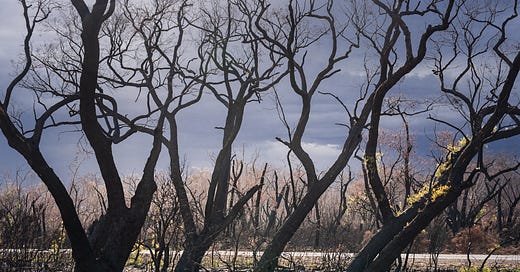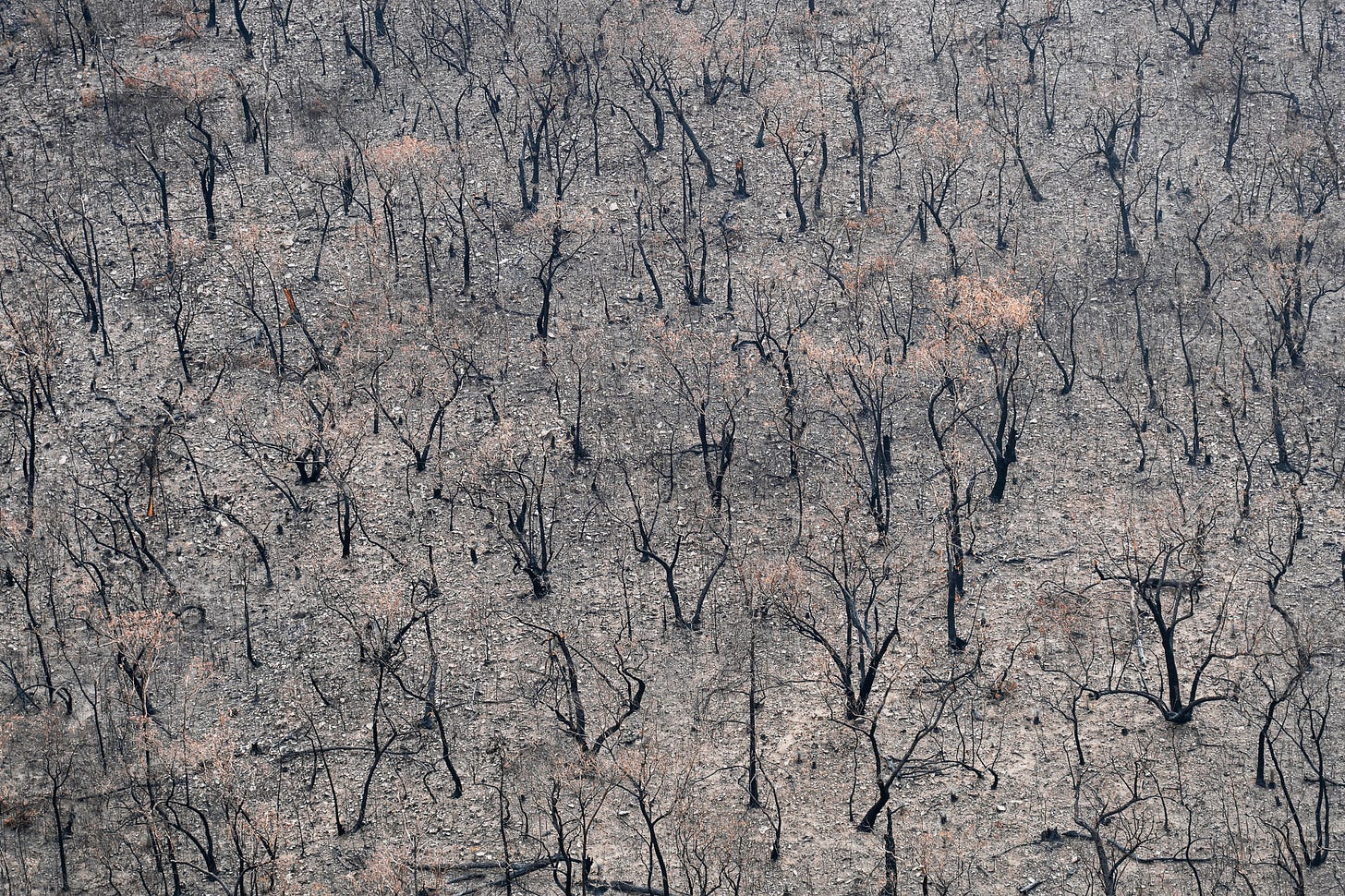The walk up in the dark is easy enough, and I find a rocky outcrop to set up. In the gloom, I can see the Grampians range (Gariwerd) extending dimly to the north.
All I can do is wait, as intermittent showers pass overhead, and hope for a moment of light. At last, it comes just for a moment, but I have got the image I hoped for.
It’s a beautiful scene, but just beyond the light is the newly formed scar on the landscape of blackened mountains and forest. Over 76,000 hectares (45%) of the Grampians National Park was burnt by a complex of fires over December and January that took three weeks to contain.
Although started by lightning, these fires were not unexpected, with much of south-west Victoria in drought with record low or near lowest rainfalls over the past two years. And these rainfall deficiencies are a more regular occurrence due to reduced cool season rainfall as a result of climate change1.
Up close, the impact is confronting. In the harsh sunlight, the landscape has been ravaged by the fire. Stripped of vegetation, the land is laid bare.
A Timeless Land
I walk amongst the burnt tree trunks, rocks and soil in solemn silence. There is no sound from birds or insects in the stillness of the early morning. Not even the air is moving. I feel how old this land is. The passage of time – over 300 million years – is evident in the exposed soil and weathered outcrops.
It is impossible to walk through the bush without touching the scorched vegetation and I am soon covered in the black welts of burnt branches.
People have lived in balance with nature along this mountain range for at least 20,000 years – a remarkable span of time compared with a single human life, the rise and fall of empires, or our domestication of plants and animals.
This continuous culture has seen change on a geological scale – the last land bridges connecting Australia to Asia were submerged some 12,000 years ago as the last ice age came to an end. And yet even this period of time is of no consequence to the land.
I embrace my insignificance – life does not start and end with humankind. But still I hope that one day we can rediscover a balance with the planet.
Up on the ridgeline, the fire must have been intense. Except in some more protected gullies and down on the flat, there is no regrowth even two months after the fires. Everything is dead except some hardy grass trees. The once dense, wind pruned banksia and eucalypts are now just twisted, blackened trunks. The only colour is the scorched orange of leaves not turned to ash.
The Future Is Already Here…
In some areas, where the fire wasn’t so hot, already life is emerging from the trees. Green shoots are sprouting from the trunks of fire adapted eucalypts. Early colonisers, mostly weeds, are emerging from the ground.
Nature has a way of healing, if given time, although small populations are vulnerable to the loss of their niche. The colony of critically endangered southern Brush-tailed Rock-wallabies was found to have escaped the fire (this time) and emergency food drops were provided. But a whole host of factors, including multiple events in quick succession, changing climate, and predation, mean recovery of native animals and vegetation is challenging2. Increasingly, larger populations of plants, animals and humans are critically impacted.
As the day progresses, the clouds return and the wind increases. Ash is picked up and flung into the air. I have to turn away, covering my eyes and camera. A misty rain sweeps across the landscape, creating surreal views through the scorched trees.
The rain is not enough to move the exposed soil, but that will come, impacting the catchment further downstream. As I take my time seeking compositions from the tangle of black, I am aware that this disaster is far from over and the landscape is completely vulnerable.
If sunburnt then, scorched now
“I love a sunburnt country,
A land of sweeping plains,
Of ragged mountain ranges,
Of droughts and flooding rains.”
– My Country, Dorothea Mackellar, 1908
There has been more change on the land in the past 200 years than the previous 20,000. And now climate change is increasing the frequency and severity of natural disasters at an accelerating rate. After hundreds of years of increasing greenhouse gases, nature has little resilience left.
I know the science of climate change. I came here wanting to experience the impacts of this change, as an increasing number of people around the world already do. But I know I can’t; I am just a tourist. I will soon be home with a record of memories I can put behind me. But not for long.
A rich country like Australia can absorb many of the impacts of climate change for a time. It is the secondary impacts of climate change on human systems (the economy and trade, liveability, social supports) that will finally mean there is no denial. The inability to get insurance for our homes (the great Australian Dream), unreliable infrastructure, water and food insecurity, fractured supply chains. Government (the taxpayer) will no longer be able to support the recovery of destroyed lives and communities as the underwriter of last resort.
I change my shirt to not bring the blackened evidence into the car, but my hands stay stained for days. To have the same hopes and expectations for my children as my parents had for me is a form of climate denial. The world is already different - the evidence is everywhere.
The blackened landscape I see today is a precursor of the world of the future – laid bare, exposed, vulnerable. A rethinking of the future is required.
As I look south towards my morning viewpoint, the beauty I see in this landscape is bittersweet.
Science-based organisations no longer beat around the bush: “The rainfall deficiency period starting in April 2023 reflects the impacts of climate change …… there has been a decline in April to October rainfall over the south-west and south-east of Australia in recent decades, with more frequent periods of below-average rainfall in these areas during these months.” – Australian Bureau of Meteorology
A colony of southern Brush-tailed Rock-wallabies was re-introduced to the Grampians in 2008 after the population fell so low the final wallaby had to be removed and put into a captive breeding program to help regenerate numbers. The reported population before the fires was thought to be 15-50 animals. Every effort is being taken to assess the impact of the fire and ensure remaining wallabies are supported - check out this video https://www.facebook.com/share/v/14wXdwSdjf8/
















A moving and sobering report. I visited the Grampians two decades ago and remember them well. I really like your writing as well, you found clear and strong words for things I've felt as well.
Beautiful and sobering all at the same time.